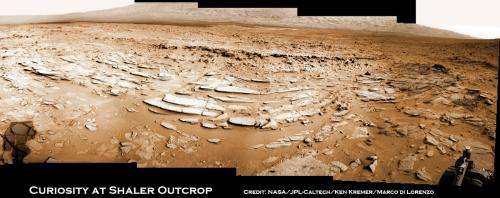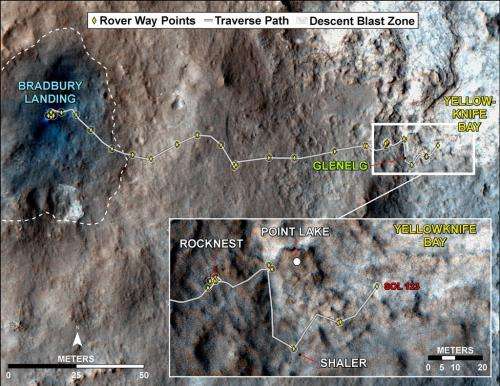Curiosity inspects 'shaler' outcrop on descent to Yellowknife Bay drill target—2D/3D

NASA's Curiosity rover is on the final steps of her descent into a geologist's paradise at an area called 'Yellowknife Bay'.
Along the way just days ago on Sol 120 (Dec 7, 2012) she stopped to inspect a huge outcrop of layered rocks dubbed 'Shaler' and snapped dozens of high resolution photos with the Navcam and Mastcam cameras.
To catch a human's eye view of the breathtaking terrain of what some might hearken to an 'unexpected journey', check out our Sol 120 photo mosaic in 2-D (above) and then compare that with NASA's 3-D photo mosaic (below). You will need to whip out you red-cyan anaglyph glasses to take in the full measure of Curiosity's glorious surroundings and the foreboding shadow – can you guess what that is?
The 'Shaler' outcrop features a plethora of striking layers, angled to each other in a pattern geologists refer to as 'crossbedding'.

The team also used Curiosity's Chemistry and Camera (ChemCam) instrument on the rover's mast to help assess the content of 'Shaler.'
With the Christmas holidays fast approaching, the rover science team is searching for a suitable location at Yellowknife Bay to select as the first potential target to drill into with Curiosity's advanced percussion drill.

Thereafter she will deliver powdered rock samples to the CheMin and SAM duo of miniaturized analytical chemistry labs on the rovers deck to elucidate the inorganic mineral composition as well as seek to determine if any organic molecules are present.
Yellowknife Bay lies within the place dubbed 'Glenelg', the rovers first major science destination. Glenelg uniquely sits at the junction of three different types of intersecting geologic features that will help unravel the mysteries of Curiosity's Gale Crater touchdown zone beside a humongous mountain known as Mount Sharp – the main target of the mission.
After safely surviving the harrowing touchdown at 'Bradbury Landing' on Aug. 6, the SUV-sized Curiosity rover has been on a roll to reach the inviting interior terrain of 'Glenelg' before Christmas.
The six wheeled robot has thus far traversed more than 0.37 mile (598 meters) and is now driving on top of the most challenging and scientifically rewarding terrain of the entire four month journey.
"The rover is traversing across terrain different from where it has driven earlier, and responding differently," said Rick Welch, mission manager at NASA's Jet Propulsion Laboratory, Pasadena, Calif. "We're making progress, though we're still in the learning phase with this rover, going a little slower on this terrain than we might wish we could."
Curiosity will spend at least several weeks thoroughly investigating Yellowknife Bay before reversing course and setting out on the year-long 6 mile (10 km) trek to the lower reaches of Mount Sharp. Along the way, the science team may possibly choose to re-investigate the Shaler and Hottah outcrops with the rover's suite of 10 state-of-the-art science instruments.
Source: Universe Today





















